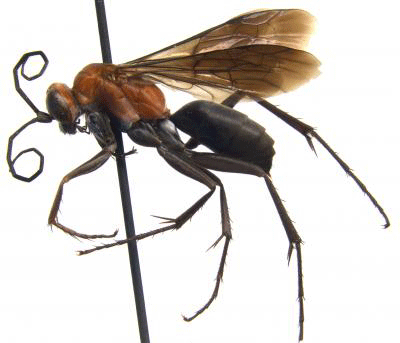
The first documented image of a redback spider-hunting wasp with its paralysed prey. Image: Florian and Peter Irwin.
The notorious redback spider has a predator of its own.
The Agenioideus nicricornis wasp is less than a centimetre long, but what it lacks in stature it makes up for in deadly hunting prowess. First described scientifically in 1775 by Johan Christian Fabricius, the Danish entomologist on board Captain Cook’s first voyage to Australia, this species has since been largely forgotten. But recently, a nine-year-old budding entomologist in Fremantle, WA, witnessed and photographed a wasp dragging a paralysed redback spider back to its nest. Researchers from the University of Adelaide were informed of the discovery, which prompted them to reopen the 200-year-old case of understanding how these wasps behave in Australia.
“This was the very first record of a spider-hunting wasp utilising the redback spider as its prey,” says Andy Austin from the University of Adelaide’s Australian Centre for Evolutionary Biology & Biodiversity. “It’s seriously gruesome… The female wasp drags the spider back to it’s nest, puts it in a crevice or a little tunnel that it has excavated, and lays an egg on the spider (which is alive but permanently paralysed). It then seals the crevice off and when the egg hatches the wasp larvae feed on the paralysed spider.”
After this striking finding, the spider-hunting wasp might just become the pin-up species for people with arachnophobia, one of the most common phobias in the world. Austin and his colleagues plan to conduct more research into determining how large an effect the mini-predator has on redback populations across the country. He speculates, based on existing measurements of the spider’s distribution throughout the year, that the wasp is a major native controller in keeping the potentially lethal spider numbers down.
“Different members of this wasp family [called Pompilidae] tend to hunt for different spiders,” explains Austin. “They hunt in particular habitats: some specialise in collecting spiders on flowers, others hunt for large active spiders running along the ground like Huntsmans. This wasp probably searches for redback spider webs in and around houses or at the base of trees and fence posts. It cues in on a certain habitat where it is likely to find its prey.”
Austin and his colleague Lars Krogman from the Stuttgart State Museum of Natural History in Germany have been working on the evolution and diversity of the whole Pompilidae wasp family for some time. Their research on the redback spider-hunting wasp has recently been published in the Australian Journal of Entomology.

The wasp has been a common specimen in museums for over 200 years, though little was known about its behaviour. Image: Lars Krogman.
Source: University of Adelaide






